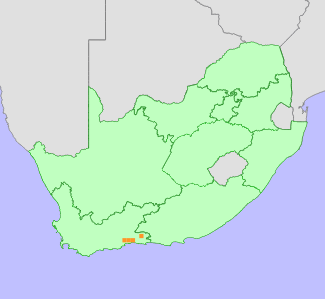|
Scientific Name | Aspalathus glabrescens R.Dahlgren |
Higher Classification | Dicotyledons |
Family | FABACEAE |
National Status |
Status and Criteria | Endangered A2c; B1ab(ii,iii,v)+2ab(ii,iii,v) |
Assessment Date | 2021/04/04 |
Assessor(s) | J.H. Vlok & D. Raimondo |
Justification | This perennial shrub with a generation length of 15 years is listed as Endangered (under criterion A2c). A population decline of more than 50% is estimated based on habitat loss due to crop cultivation and alien plant invasion over the past 40 years. This decline due to unmanaged alien invasion is continuing. An estimated extent of occurrence of below 5000 km² (EOO = 876 - 1401 km²), an area of occupancy below 500 km² (AOO = 40 - 304 km²) and a continuing decline in the area of occupancy, as well as in the area, extent and/or quality of habitat, means this species that has a severely fragmented population also meets the threshold for the Endangered category under Criterion B1b(ii,iii) + 2b(ii,iii). |
Distribution |
Endemism | South African endemic |
Provincial distribution | Western Cape |
Range | It is distributed in the northern slopes of the Outeniqua Mountains between Robinson Pass and Uniondale. |
Habitat and Ecology |
Major system | Terrestrial |
Major habitats | Langkloof Shale Renosterveld, Uniondale Shale Renosterveld, North Outeniqua Sandstone Fynbos |
Description | Plants grow in disturbed renosterveld-fynbos scrub in dry, pebbly, loamy soil on north-facing slopes. |
Threats |
| Competition from unmanaged, alien invasive hakeas and pines are a severe, ongoing threat at all known remaining locations. More than 50% of this species' habitat has been converted to crop fields, and loss continues sporadically. |
Population |
A population reduction of more than 50% is estimated based on habitat loss due to crop cultivation and alien plant invasion over the past 40 years (generation length suspected to be 15 years). The population decline due to unmanaged alien invasion is continuing. Extensive monitoring of this species by citizen scientists between 2014 and 2021 indicate that the majority of subpopulations are small (fewer than 50 plants) and are isolated from one another the population is thus considered to be severely fragmented.
|
Population trend | Decreasing |
Assessment History |
Taxon assessed |
Status and Criteria |
Citation/Red List version | | Aspalathus glabrescens R.Dahlgren | EN A2c | Raimondo et al. (2009) | | Aspalathus glabrescens R.Dahlgren | Indeterminate | Hilton-Taylor (1996) | |
Bibliography |
Dahlgren, R. 1988. Crotalarieae (Aspalathus). In: O.A. Leistner (ed). Flora of southern Africa 16 Fabaceae, Part 3 Papilionoideae, Fascicle 6:1-430. National Botanical Institute, Pretoria.
Goldblatt, P. and Manning, J.C. 2000. Cape Plants: A conspectus of the Cape Flora of South Africa. Strelitzia 9. National Botanical Institute, Cape Town.
Hilton-Taylor, C. 1996. Red data list of southern African plants. Strelitzia 4. South African National Botanical Institute, Pretoria.
Raimondo, D., von Staden, L., Foden, W., Victor, J.E., Helme, N.A., Turner, R.C., Kamundi, D.A. and Manyama, P.A. 2009. Red List of South African Plants. Strelitzia 25. South African National Biodiversity Institute, Pretoria.
|
Citation |
| Vlok, J.H. & Raimondo, D. 2021. Aspalathus glabrescens R.Dahlgren. National Assessment: Red List of South African Plants version 2024.1. Accessed on 2025/10/26 |
 Comment on this assessment
Comment on this assessment


